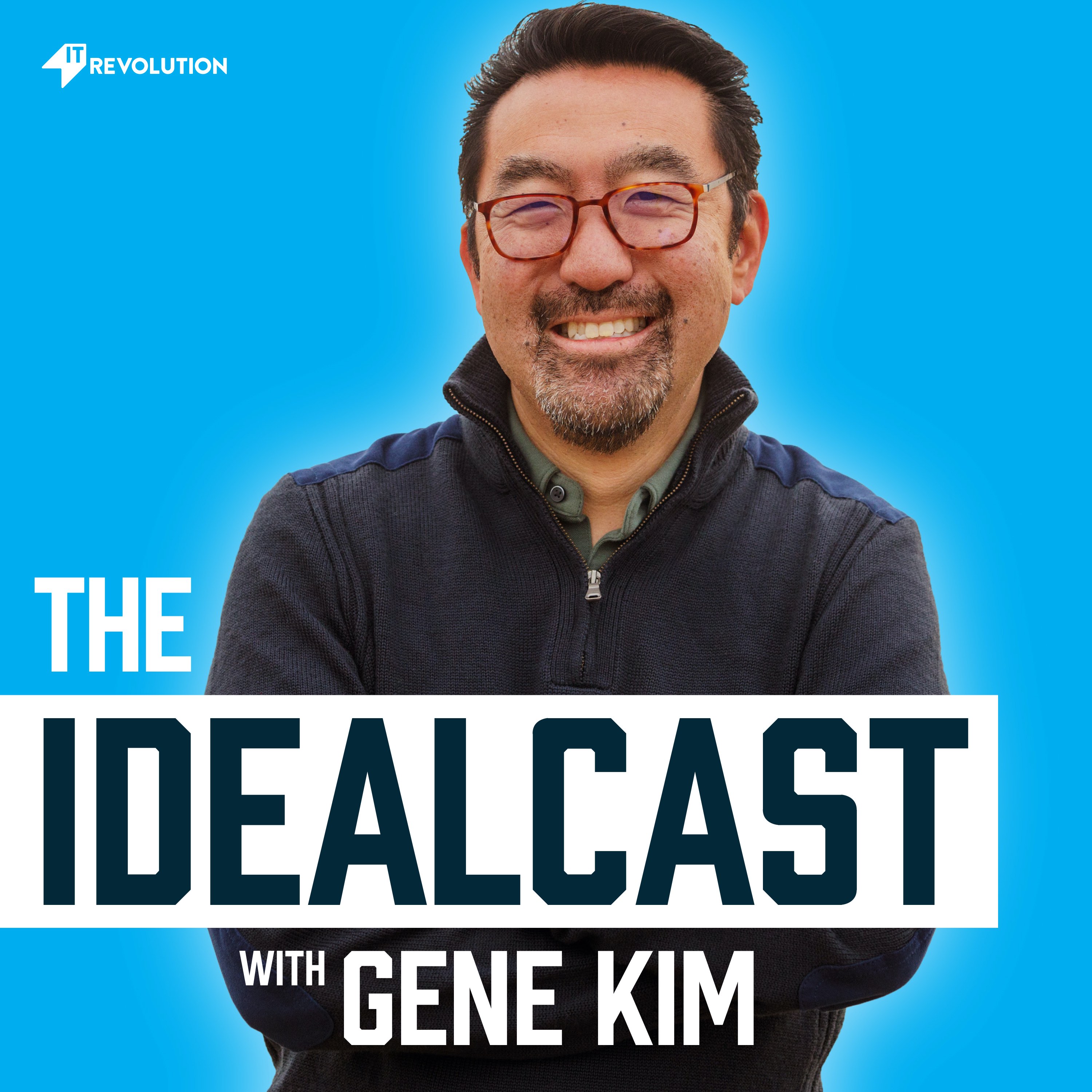Episodes
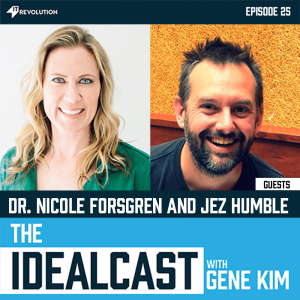
Thursday Jan 27, 2022
Thursday Jan 27, 2022
In part two of this two-part episode on The DevOpsHandbook, Second Edition, Gene Kim speaks with coauthors Dr. Nicole Forsgren and Jez Humble about the past and current state of DevOps. Forsgren and Humble share with Kim their DevOps aha moments and what has been the most interesting thing they’ve learned since the book was released in 2016.
Jez discusses the architectural properties of the programming language PHP and what it has in common with ASP.NET. He also talks about the anguish he felt when Mike Nygard’s book, Release It!, was published while he was working on his book, Continuous Delivery.
Forsgren talks about how it feels to see the findings from the State of DevOps research so widely used and cited within the technology community. She explains the importance of finding the link between technology performance and organizational performance as well as what she's learned about the importance of culture and how it can make or break an organization.
Humble, Forsgren, and Kim each share their favorite case studies in The DevOps Handbook.
ABOUT THE GUEST(S)
Dr. Nicole Forsgren and Jez Humble are two of five coauthors of The DevOps Handbook along with Gene Kim, Patrick Debois and John Willis.
Forsgren, PhD, is a Partner at Microsoft Research. She is coauthor of the Shingo Publication Award-winning book Accelerate: The Science of Lean Software and The DevOps Handbook, 2nd Ed., and is best known as lead investigator on the largest DevOps studies to date. She has been a successful entrepreneur (with an exit to Google), professor, performance engineer, and sysadmin. Her work has been published in several peer-reviewed journals.
Humble is co-author of Lean Enterprise, the Jolt Award-winning Continuous Delivery, and The DevOps Handbook. He has spent his career tinkering with code, infrastructure, and product development in companies of varying sizes across three continents, most recently working for the US Federal Government at 18F. As well as serving as DORA’s CTO, Jez teaches at UC Berkeley.
YOU’LL LEARN ABOUT
- Projects Jez and Gene worked on together before The DevOps Handbook came out.
- What life is like for Jez as a site reliability engineer at Google and what he’s learned.
- The story behind his DevOps aha moment in 2004, working on a large software project involving 70 developers.
- The architectural properties of his favorite programming language PHP, what it has in common with ASP.NET, and the importance of being able to get fast feedback while building something.
- The anguish that Jez felt when Mike Nygard’s book, Release It!, came out, wondering if there was still a need for the book he was working on, which was Continuous Delivery.
- “Testing on the Toilet” and other structures for creating distributed learning across an organization and why this is important to create a genuine learning dynamic.
- What Dr. Forsgren is working on now as Partner of Microsoft Research.
- Some of Dr. Forsgren’s goals as we work together on the State of DevOps research and how it feel to have those findings so widely used and cited within the technology community.
- The importance of finding the link between technology performance and organizational performance and why it probably was so elusive for at least 40 years in the research community.
- What Dr. Forsgren has learned about the importance of culture, how it can make or break an organization, and the importance of great leadership.
RESOURCES
- Personal DevOps Aha Moments, the Rise of Infrastructure, and the DevOps Enterprise Scenius: Interviews with The DevOps Handbook Coauthors (Part 1 of 2: Patrick Debois and John Willis)
- The DevOps Handbook: How to Create World-Class Agility, Reliability, and Security in Technology Organizations, Second Edition, by Gene Kim, Patrick Debois, John Willis, Jez Humble, and Dr. Nicole Forsgren
- Nudge: Improving Decisions About Health, Wealth, and Happiness by Richard H. Thaler and Cass R. Sunstein
- Nudge vs Shove: A Conversation With Richard Thaler
- The Visible Ops Handbook: Implementing ITIL in 4 Practical and Auditable Steps by Kevin Behr, Gene Kim and George Spafford
- FlowCon
- Elisabeth Hendrickson on the Idealcast: Part 1, Part 2
- Cloud Run
- Beyond Goldilocks Reliability by Narayan Desai, Google
- Continuous Delivery: Reliable Software Releases through Build, Test, and Deployment Automation by Jez Humble and David Farley
- Release It!: Design and Deploy Production-Ready Software (Pragmatic Programmers) by Michael T. Nygard
- DevOps Days
- On the Care and Feeding of Feedback Cycles by Elisabeth Hendrickson at FlowCon San Francisco 2013
- Bret Victor
- Inventing on Principle by Bret Victor
- Media for Thinking the Unthinkable
- Douglas Engelbart and The Mother of All Demos
- 18F
- Pain Is Over, If You Want It at DevOps Enterprise Summit - San Francisco 2015
- Goto Fail, Heartbleed, and Unit Testing Culture by Mike Bland
- Do Developers Discover New Tools On The Toilet? by Emerson Murphy-Hill, Edward Smith, Caitlin Sadowski, Ciera Jaspan, Collin Winter, Matthew Jorde, Andrea Knight, Andrew Trenk and Steve Gross PDF
- Study: DevOps Can Create Competitive Advantage
- DevOps Means Business by Nicole Forsgren Velasquez, Jez Humble, Nigel Kersten and Gene Kim
- Accelerate: The Science of Lean Software and DevOps: Building and Scaling High Performing Technology Organizations by Nicole Forsgren, PhD, Jez Humble, and Gene Kim
- DevOps Research and Assessment (DORA) on Google Cloud
- GitLab Inc. takes The DevOps Platform public
- Paul Strassmann
- The Idealcast with Dr. Ron Westrum: Part 1, Part 2
- Building the Circle of Faith: How Corporate Culture Builds Trust at Trajectory Conference 2021
- The Truth About Burnout: How Organizations Cause Personal Stress and What to Do About It by Christina Maslach and Michael P. Leiter
- Maslach Burnout Inventory
- Understanding Job Burnout at DevOps Enterprise Summit - Las Vegas 2018
- Understanding Job Burnout at DevOps Enterprise Summit - London 2019
- Workplace Engagement Panel at DevOps Enterprise Summit - Las Vegas 2019
- Expert Panel - Workplace Engagement & Countering Employee Burnout at DevOps Enterprise Summit - London 2019
- The Idealcast with Trent Green
- Kelly Shortridge’s tweets about Gitlab S-1
TIMESTAMPS
[05:22] Intro
[05:34] Meet Jez Humble
[10:19] What Jez is working on these days
[15:56] What inform his book, “Continuous Delivery”
[24:02] Assembling the team for the project
[26:30] At what point was PHP an important property
[31:56] The most surprising thing since the DevOps Handbook came out
[35:07] His favorite pattern that went into the DevOps Handbook
[43:40] What DevOps worked on in 2021
[44:46] Meet Dr. Nicole Forsgren
[50:32] What Dr. Forsgren is working on these days
[52:18] What it’s like working at Microsoft Research
[55:58] The response to the state of DevOps findings
[59:18] The most surprising finding since the findings release
[1:05:59] Her favorite pattern that influence performance
[1:08:49] How Dr. Forsgren met Dr. Ron Westrum
[1:11:06] The most important thing she’s learned in this journey
[1:14:46] Her favorite case study in the DevOps Handbook
[1:19:12] Dr. Christina Maslach and work burnout
[1:20:46] More context about the case studies
[1:25:32] The Navy case study
[1:29:04] Outro

Thursday Dec 16, 2021
Thursday Dec 16, 2021
In part one of this two-part episode on The DevOpsHandbook, Second Edition, Gene Kim speaks with coauthors Patrick Debois and John Willis about the past, present, and future of DevOps. By sharing their personal stories and experiences, Kim, Debois, and Willis discuss the scenius that inspired the book, and why and how the DevOps movement took hold around the world.
They also examine the updated content in the book, including new case studies, updated metrics, and practices. Finally, they each share the new lessons they have learned since writing the handbook and the future challenges they think DevOps professionals need to solve for the future.
Kim will conclude the series in Part 2, where he interviews the remaining two coauthors, Jez Humble and Dr. Nicole Forsgren.
ABOUT THE GUEST(S)
Patrick Debois is considered to be the godfather of the DevOps movement after he coined the term DevOps accidentally in 2008. Through his work, he creates synergies projects and operations by using Agile techniques in development, project management, and system administration. He has worked in several companies such as Atlassian, Zender, and VRT Media Lab. Currently, he is a Labs Researcher at Synk and an independent IT consultant.
John Willis an author and Senior Director of the Global Transformation Office at Red Hat.. He has been an active force in the IT management industry for over 35 years. Willis’ experience includes being the Director of Ecosystem Development at Docker, the VP of Solutions for Socketplane, the VP of Training and Services at Opscode. He also founded Gulf Breeze Software, an award-winning IBM business partner, which specializes in deploying Tivoli technology for the enterprise.
Patrick DeBois and John Willis are two of five coauthors of The DevOps Handbook along with Gene Kim, Jez Humble, and Nicole Forsgren, PhD.
YOU’LL LEARN ABOUT
- The DevOps origin story from coining the term, why it took off, to launching the DevOps Days conference as an offshoot of the velocity conference.
- How people thought of DevOps when it was first presented (their reactions, their mentalities, and their willingness to adopt it).
- What has changed in the DevOps world since the first edition of The DevOps Handbook was published.
- How the rise of SaaS companies is altering the DevOps world and participating in its evolution, and how building solid relationships with SaaS vendors and communicating comprehensive feedback to them is integral to DevOps.
- The significance of speed in changing team dynamics.
- Why resilient companies like Google and Amazon engineer chaos, and why companies like Toyota are happy when production stoppages happen.
- Why you can’t afford to provide a high variety of products if you also offer high product variation.
RESOURCES
- Get The DevOps Handbook (Second Edition)
- Nudge vs Shove: A Conversation With Richard Thaler
- Solaris Zones wiki
- Agile Conference in Toronto 2008
- Sys Advent article: In Defense of the Modern Day JVM (Java Virtual Machine) by Gene Kim
- Mob programming
- Breaking Traditional IT Paradigms to... (San Francisco 2015)
- Crowdsourcing Technology Governance (Las Vegas 2018)
- Laying Down the Tracks for Technical Change at Comcast (Las Vegas 2020)
- 10+ Deploys Per Day by John Allspaw and Paul Hammond
- 10+ Deploys Per Day
- How chaos engineering works at Vanguard
- Patrick DeBois tweet mapping out all the failure modes of an online conference.
- Jesse Robins LinkedIn
- Jesse Robbins on Twitter
- How A Hotel Company Ran $30B of Revenue In Containers (Las Vegas 2020) by Dwayne Holmes
- Google Cloud Certified Fellow Program
- Operations is a competitive advantage… (Secret Sauce for Startups!)
- Love Letter To Conferences (And What Makes Some Truly Amazing) by Gene Kim
- Toyota Kata: Managing People for Improvement, Adaptiveness and Superior Results by Mike Rother
- Profound podcast by John Willis
- Ben Rockwood on Twitter
- Luke Kanies on LinkedIn
- DevOps 2020 - The Next Decade (London 2020)
- Beyond the Phoenix Project: The Origins and Evolution of DevOps by Gene Kim and John Willis
- The Goal: A Process of Ongoing Improvement by Eliyahu M. Goldratt and Jeff Cox
- The Convergence Of DevOps
- Operations as a Strategic Weapon by John Willis
- Iterative Enterprise SRE Transformation (US 2021)
TIMESTAMPS
[00:00] Intro
[01:18] What’s new and improved in the second edition of the DevOps handbook
[03:56] Meet Patrick DeBois
[10:35] How faster technology made ideas like DevOps possible
[18:11] The myths and inefficiencies of team autonomy
[20:04] What the first DevOps days were like
[27:59] Different opinions between the dev community and ops community
[30:49] Mob programming and the future of collaboration
[39:31] Two surprising things Patrick learned about DevOps
[47:20] Patrick DeBois’ favorite DevOps patterns
[51:28] How fear of not delivering on time can mask technical errors
[59:45] What Patrick DeBois is working on these days
[1:04:38] What was expanded in the second edition of the DevOps handbook
[1:06:30] How Gene Kim entered the DevOps world.
[1:07:38] Meet John Willis
[1:10:42] Why the DevOps movement took off
[1:16:00] Mastering production disasters
[1:23:32] The birth of the DevOps Days conference
[1:37:37] Feelings of belonging and connection in a conference
[1:41:29] A few clarifications
[1:49:32] Two of the greatest DevOps open spaces
[1:52:40] The difference between variety and variation (the cost of knowledge work).
[2:07:12] Why you should want more stoppages in your production line
[2:10:16] John Willis’ two favorite DevOps case studies
[2:18:55] Outro

Thursday Sep 23, 2021
Thursday Sep 23, 2021
In this episode of The Idealcast, Gene Kim speaks with Scott Havens, who is the Director of Engineering at Wayfair, where he leads Engineering for the Wayfair Fulfillment Network. Havens is a leading proponent of applying functional programming principles to technical and organizational design. Previously, Havens was the architect for Walmart's global omnichannel inventory system, unifying availability and replenishment for the largest company in the world by revenue.
Havens shares his views on what makes great architecture great. He details what happened when an API call required 23 other synchronous procedures calls to return a correct answer. He discusses the challenges of managing inventory at Wal-Mart, how one implements event sourcing patterns on that scale, and the functional programming principles that it depends upon. Lastly, he talks about how much category theory you need to know to do functional programming and considerations when creating code in complex systems.
Before listening to this interview, please listen to Episode 22, which provides Scott Havens's 2019 DevOps Enterprise Summit talk with commentary from Gene Kim.
ABOUT THE GUEST(S)
Scott Havens is a Director of Engineering at Wayfair, where he leads Engineering for the Wayfair Fulfillment Network. Scott cares deeply about scalable data-intensive software systems; he is a leading proponent of applying functional programming principles to technical and organizational design. Previously, Havens was a Director of Engineering at Jet.com and was the architect for Walmart's global omnichannel inventory system, unifying availability and replenishment for the largest company in the world by revenue.
In his home life, Havens enjoys good food, good wine, bad movies, and asking his daughter to stop "redecorating" his Minecraft castles, pretty please.
LinkedIn: https://www.linkedin.com/in/scott-havens/
Twitter: @ScottHavens
Email: scott@sphavens.com
YOU’LL LEARN ABOUT
- His views on what makes great architectures great
- The details on what happened when an API call requires 23 other synchronous procedures calls to return a correct answer
- How one implements event sourcing patterns on a large scale, using Wal-Mart as an example, and the functional programming principles it depends upon
- The challenges of managing inventory at Wal-Mart
- How much category theory to know to do functional programming
RESOURCES
- Currying
- Function composition (computer science)
- Idempotence
- Love Letter To Clojure: And A Datomic Experience Report - Gene Kim
- Side effect (computer science)
- Functional Geekery Episode 129 – Eric Normand
- Theory of Functional Programming skill
- Ruby Conf 12 - Boundaries by Gary Bernhardt
- Functional Design in Clojure Podcast - Ep 021: Mutate the Internet
- Lean Summit 2013 - Art Byrne - What does it take to Lead a Lean Turnaround?
- Thoughts On Functional Programming Podcast - 3 Examples Of Algebraic Thinking
- CORECURSIVE #050 - Portal Abstractions with Sam Ritchie: How abstract algebra solves data engineering
- Adam Grant’s tweet about coding
TIMESTAMPS
[00:24] Intro
[02:23] Meet Scott Havens
[03:48] How architecture fits in functional programming
[04:48] Event source systems at Wal-Mart
[19:45] The effects and behaviors
[22:36] Duality of code and data
[26:13] Currying
[32:34] How the 23 service teams’s world change
[40:56] Hallmarks of great architecture
[51:10] How he replaced the dominant architecture at Wal-Mart
[56:46] Configurations and speculations with couplings
[1:03:51] How can simple systems suffer from problems like this
[1:09:11] Idempotence, Clojure and side effect
[1:17:01] Issues with switching to event-driven asynchronous architectures
[1:25:15] Vast scale in which these organizations operate in
[1:29:54] A moment that showed Scott the effects of what he helped create
[1:33:51] Onboarding new engineers to the new system
[1:45:11] Working in the Windows 3.1 multicast networking group
[1:47:32] Reflection on Moda Operandi experience
[1:52:11] Advice to someone who wants to replicate Scott’s journey
[1:56:17] What to understand about category theory and algebraic thinking
[2:01:11] How to contact Scott
[2:02:48] Outro
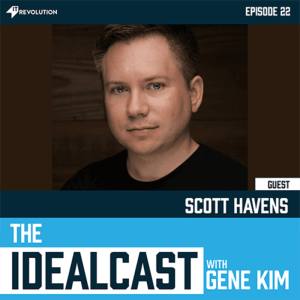
Tuesday Sep 21, 2021
Tuesday Sep 21, 2021
In this episode of The Idealcast, Gene Kim shares and gives commentary on Scott Havens’ talk from the 2019 DevOps Enterprise Summit Las Vegas. Havens is a Director of Engineering at Wayfair, where he leads Engineering for the Wayfair Fulfillment Network. He is a leading proponent of applying functional programming principles to technical and organizational design. Previously, Scott was the architect for Walmart's global omnichannel inventory system, unifying availability and replenishment for the largest company in the world by revenue.
In his 2019 DevOps Enterprise Summit talk, Havens highlights functional programming and e-commerce systems work. He also talks about what he did to massively simplify those systems while also making them more testable, reliable, cheaper to operate, and easier to change. Finally, he discusses the implications of using functional programming to change how to design systems and systems of systems on a larger scale.
ABOUT THE GUEST
Scott Havens is Director of Engineering at Wayfair, where he leads Engineering for the Wayfair Fulfillment Network. Scott cares deeply about scalable data-intensive software systems. He is a leading proponent of applying functional programming principles to technical and organizational design. Previously, Scott was Director of Engineering at Jet.com and was the architect for Walmart’s global omnichannel inventory system, unifying availability and replenishment for the largest company in the world by revenue.
In his home life, Scott enjoys good food, good wine, bad movies, and asking his daughter to stop “redecorating” his Minecraft castles, pretty please.
LinkedIn: https://www.linkedin.com/in/scott-havens/
Twitter: @ScottHavens
Email: scott@sphavens.com
YOU’LL LEARN ABOUT
- Functional programming and what it is.
- How e-commerce systems work.
- What Havens did to massively simplify those systems while also making them more testable, reliable, cheaper to operate, and easier to change.
- The implications of using functional programming to change how to design systems and systems of systems on a larger scale.
RESOURCES
- Fabulous Fortunes, Fewer Failures, and Faster Fixes from Functional Fundamentals: Scott Havens’ 2019 DevOps Enterprise Summit Talk
- Slidedeck for the Havens’ 2019 DOES talk
- Clojure
- Pass by reference (C++ only)
- John Carmack
- John Carmack Keynote - Quakecon 2013
- Panther Systems
TIMESTAMPS
[00:24] Intro
[02:52] Functional programming
[07:59] Gene introduces Scott
[09:13] Working at Wal-Mart
[11:13] Disaster struck
[14:10] One common piece of e-commerce website functionality
[17:07] The implications of functional programming for system design
[21:05] Changing how to design systems and systems of systems
[28:55] Using Panther
[33:11] How this affects the hot path and cost
[36:43] One bite a time
[37:52] Contacting Scott
[38:13] Outro
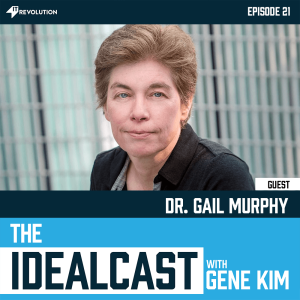
Thursday Sep 02, 2021
Thursday Sep 02, 2021
In this newest episode of The Idealcast, Gene Kim speaks with Dr. Gail Murphy, Professor of Computer Science and Vice President of Research and Innovation at the University of British Columbia. She is also the co-founder, board member, and former Chief Scientist at Tasktop. Dr. Murphy’s research focuses on improving the productivity of software developers and knowledge workers by providing the necessary tools to identify, manage, and coordinate the information that matters most for their work.
During the episode, Kim and Dr. Murphy explore the properties of modularity and information hiding, and how one designs architectures that create them. They also discuss how open source libraries create the incredible software supply chains that developers benefit from everyday, and the surprising new risks they can create.
They discuss the ramifications of system design considerations and decisions made by software developers and why defining software developers’ productivity remains elusive. They further consider open-source software as a triumph of information hiding and how it has created a massively interdependent set of libraries while also enabling incredible co-evolution, which is only made possible by modularity. Listen as Kim and Dr. Murphy discuss how technologists have both succeeded and fallen short on the dream of software being like building blocks, how software development is a subset of knowledge work, and the implications of that insight.
ABOUT THE GUEST
Gail C. Murphy is a Professor of Computer Science and Vice President of Research and Innovation at the University of British Columbia. She is a Fellow of the Royal Society of Canada and a Fellow of the Association for Computing Machinery (ACM), as well as co-founder, board member, and former Chief Scientist at Tasktop.
After completing her BS at the University of Alberta in 1987, she worked for five years as a software engineer in the Lower Mainland. She later pursued graduate studies in computer science at the University of Washington, earning first a MS (1994) and then a PhD (1996) before joining University of British Columbia.
Dr. Murphy’s research focuses on improving the productivity of software developers and knowledge workers by providing the necessary tools to identify, manage, and coordinate the information that matters most for their work. She also maintains an active research group with post-doctoral and graduate students.
YOU’LL LEARN ABOUT
- Why defining software developers’ productivity remains elusive and how developers talk about what factors make them feel productive.
- The value of modularity and how one can achieve it.
- Ways to decompose software that can have surprising outcomes for even small systems.
- How open-source software is a triumph of information hiding, creating a massively interdependent set of libraries that also enable incredible co-evolution, which is only made possible by modularity.
- How we have exceeded and fallen short of the 1980s dream of software being like building blocks, where we can quickly create software by assembling modules, and what we have learned from the infamous leftpad and mime-magic incidents in the last two years.
- Why and how, in very specific areas, the entire software industry has standardized on a set of modules versus in other areas, where we continue to seemingly go in the opposite direction.
- A summary of some of the relevant work of Dr. Carliss Baldwin, the William L. White Professor of Business Administration at the Harvard Business School. Dr. Baldwin studies the process of design and its impact of design architecture on firm strategy, platforms, and business ecosystems.
- How software development is a subset of knowledge work and the implications of that insight.
RESOURCES
- Dr. Mik Kersten on The Idealcast
- Project to Product: How to Survive and Thrive in the Age of Digital Disruption with the Flow Framework by Mik Kersten
- Tasktop
- The Unicorn Project: A Novel about Developers, Digital Disruption, and Thriving in the Age of Data by Gene Kim
- Fred Brooks
- The Mythical Man-Month
- On the Criteria To Be Used in Decomposing Systems into Modules by Dr. D.L. Parnas
- Comparison of embedded computer systems on board the Mars rovers
- Joshua Bloch
- How to design a good API and why it matters by Joshua Bloch
- Tricking Sand into Thinking: Deep Learning in Clojure by Dave Liepmann
- Gene Kim’s reaction on Twitter
- Gource
- Gource in Bloom
- 800+ days of Minecraft in 8 minutes
- History of Bitcoin
- History of Python
- Eclipse Mylyn by Dr. Mik Kersten
- How one developer just broke Node, Babel and thousands of projects in 11 lines of JavaScript
- Laurie Voss’ tweet
- Rails 5.2.5, 6.0.3.6 and 6.1.3.1 have been released
- Have there been any lawsuits involving breach of open source licences?
- GNU General Public License
- SemanticConflict
- Fostering Software Developer Productivity through Awareness Increase and
- Goal-Setting by André Meyer
- Gail Murphy on Mik + One Podcast
- On the criteria to be used in decomposing systems into modules
- Thoughts on Functional Programming Podcast by Eric Normand
- Alistair Cockburn’s programming challenge on Twitter
- Gene Kim’s tweet about BLAS: Basic Linear Algebra Subprograms
- Gene Kim’s tweet about the Gource visualization on the scores of people making commits to the Python ecosystem repo
- Gene Kim’s Twitter thread about Dr. Carliss Baldwin’s talk: Part 1, Part 2
- Academy of Management 2015 TIM Distinguished Scholar Prof Carliss Baldwin
- Design Rules, Vol. 1: The Power of Modularity by Carliss Y. Baldwin and Kim B. Clark
- Robert C. Merton
- Black–Scholes model
- Product Design and Development by Karl Ulrich
- Design structure matrix
- Three design structure matrices
- Real Option
TIMESTAMPS
[00:27] Intro
[03:52] Meet Dr. Murphy
[04:32] Determining where design occurs in software development
[10:30] Refactoring
[16:08] Defining developer productivity and why it defies explanation
[20:26] What is modularity, architecture and why they’re important
[28:52] An extreme example
[30:51] Information hiding
[36:06] The leftpad and mime-magic incidents and SemanticConflict
[44:13] The work of André Meyer
[47:23] Open source is a triumph of information hiding
[52:56] Architectures give different trade offs to different problems
[57:25] Relationships between a leader’s roles and responsibilities
[1:05:10] BLAS: Basic Linear Algebra Subprograms
[1:09:20] Communication paths within an organization
[1:16:58] The Mylyn project
[1:20:11] Analysis of Dr. David Parnas’ 1972 paper
[1:26:23] Falcon missile program and socio-technical congruence
[1:31:10] The work of Dr. Carliss Baldwin
[1:40:01] How Dr. Baldwin defines modularity
[1:47:26] Modularity and open source software
[1:51:31] Defining real options
[1:53:17] 1 billion dollar rearchitecture project
[1:55:29] This work is primarily about making decisions
[2:01:58] Open source systems are Darwinian systems
[2:06:33] Dr. Murphy’s ideal of software developer’s daily work
[2:09:53] How to contact Dr. Murphy
[2:11:01] Outro
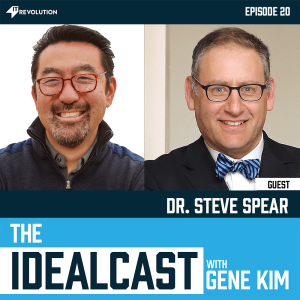
Wednesday Aug 04, 2021
Wednesday Aug 04, 2021
In this episode of The Idealcast, Gene Kim speaks with Dr. Steven Spear on his critiques of several articles from the NY Times and the Wall Street Journal, and their characterization of the impact of Just-in-Time (JIT) supply chains and the widespread shortages caused by the COVID-19 global pandemic. While the unprecedented health crisis created a widespread shortage of almost everything—from toilet paper to semiconductor chips to raw materials vital for medical materials—with results that impacted everyday life on a global scale, Dr. Spear makes the claim that JIT lessened the severity of shortages, as opposed to causing them.
The discussion is informed by Spear’s work on accelerating learning dynamics within organizations and the Toyota Production System, and from his time observing and working directly with a tier-one Toyota supplier. Kim and Spear dive deep into supply chain dynamics and why they are important to society. The discussion delves into how JIT manufacturing not only revolutionized manufacturing but also the entire manufacturing supply chain and how it increased (not decreased) resilience, productivity, efficiency, and prosperity.
They also explore the structure and dynamics of these JIT supply chains, as well as the similarities of the famous Netflix Chaos Monkey, famous for helping Netflix build resilient services that can survive even widespread cloud outages and the larger, emerging field of Chaos Engineers (arguably, a subset of resilience engineering).
Additionally, they explore Toyota’s manufacturing and how its history helped it become one of the least impacted by the semiconductor shortages. They follow that with an examination of the JIT’s antithesis and how it’s similar to the dynamics found in the Soviet’s centrally planned economy, particularly with its IT structure and dynamic results. Kim and Spear tie these things into the three basic tools of finance: net present value, option theory, and portfolio diversification.
ABOUT THE GUESTS
Dr. Steve Spear (DBA MS MS) is principal for HVE LLC, the award-winning author of The High-Velocity Edge, and patent holder for the See to Solve Real Time Alert System. A Senior Lecturer at MIT’s Sloan School and a Senior Fellow at the Institute, Dr. Spear’s work focuses on accelerating learning dynamics within organizations so that they know better and faster what to do and how to do it. This has been informed and tested in practice in multiple industries including heavy industry, high tech design, biopharm R&D, healthcare delivery and other social services, US Army rapid equipping, and US Navy readiness.
YOU’LL LEARN ABOUT
- What are supply chains, why they’re so vast and complex, and why they are important to society
- How Just-in-Time (JIT) manufacturing revolutionize manufacturing, the entire manufacturing supply chain, and the supply chain for basically everything
- How JIT increased, not deceased, the resilience of the supply chain
- Why Toyota is one of the auto manufacturers least impacted by the semiconductor shortages, partially as a result of what they learned during the Fukushima earthquake and tsunami in 2011
- How the structure and dynamics of the Toyota supply chain are almost exactly the same as the structure and dynamics of great systems discussed in previous episodes, such as the COVID mass vaccination clinic with Trent Green and Team of Teams
- How Toyota has the ability to reconfigure themselves with a low cost of change
- How these principles are very similar to Netflix chaos monkey and the entire field of what is now called chaos engineering
- How the antithesis of JIT is similar to the dynamics found in the Soviet’s centrally planned economy, particularly with its IT structure and results in dynamics
- How inventory is a substitute for knowledge
- How this all ties into the three basic tools of finance: net present value, option theory, and portfolio diversification
RESOURCES
- Announcing New Book from Gene Kim and Dr. Steven J. Spear
- NPR: Plastic Is The New Toilet Paper For Scientists
- New York Times: Shopping for Fashion, Six Months On
- Planet Money: Negative Oil
- New York Times: How the World Ran Out of Everything
- New York Times: ‘I’ve Never Seen Anything Like This’: Chaos Strikes Global Shipping
- Wall Street Journal: Auto Makers Retreat From 50 Years of ‘Just in Time’ Manufacturing
- The Mainframe DevOps Team Saves the Day at Walmart
- Frontline: Always Low Prices
- “The Beer Game” by Prof. John D. Sterman
- Lean manufacturing
- Baseline: The End of the Just in Time Supply Chain Method
- Fast Company: Living in Dell Time
- CNBC: We traced what it takes to make an iPhone, from its initial design to the components and raw materials needed to make it a reality
- An Econometric Analysis of Inventory Turnover Performance in Retail Services by Vishal Gaur, Marshall L. Fisher, and Ananth Raman
- Inventory to Sales Ratio
- Gross Profit Margin
- Using FRED site to to calculate ratios of inventory to sales from 1946 to now
- Walmart vs. Amazon
- Reuters: Half of U.S. auto suppliers face bankruptcy: study
- 21st Century Jet - Building the Boeing 777 Episode 3
- Boeing 777 — The Ultimate History (II)
- ASTA SOLUTIONS PTY. LTD.
- 21st Century Jet - Building the Boeing 777 Episode 2
- See Every Single Part Inside an iPhone
- Code as supply chain
- How Many Millions of Lines of Code Does It Take?
- Top 15 Biggest Car Manufacturers in the World (1999 - 2017)
- Moore's Law graphed vs real CPUs & GPUs 1965 - 2019
- The Myth of Productivity vs Compliance: How To Have It All
- Reuters: How Toyota thrives when the chips are down
- BBC News: Tesla partners with nickel mine amid shortage fears
- Fukushima Daiichi nuclear disaster
- Forbes: Toyota's 'Quake-Proof' Supply Chain That Never Was
- The Netflix Simian Army
- Basic Economics by Thomas Sowell
- Los Angeles Business Journal: Just-in-Time Inventory System Proves Vulnerable to Labor Strife
- Closed California ports impact on the supply chain
- “We’d Have to Sink the Ships”: Impact Studies and the 2002 West Coast Port Lockout by Peter V. Hall
- Reuters: How Toyota thrives when the chips are down
- “The Simpsons” evolution
- Example of language of simplification and stabilization
TIMESTAMPS
[00:37] Intro
[09:07] What Dr. Spear found objectionable in the NYT article
[13:41] How JIT increased resilience of the supply chain
[17:18] What are supply chains and what makes it so complex
[24:11] The economic impact of inventory and recapture
[28:17] The impact created by mass adoption of JIT practices
[42:00] JIT vs lean manufacturing
[44:46] How Toyota could handle the semiconductor shortage
[51:19] An example of the resilience of Toyota’s supply chain and manufacturing capabilities
[57:03] How to motivate everyone to mobilize
[1:02:12] What happened with Netflix’s chaos monkey and EYE-shin mattress factory plant
[1:08:13] Twitter feedback
[1:09:37] The link between experimentation at the EYE-shin plant and low cost of change
[1:17:30] Four characters of simplification, standardization, stabilization and synchronization
[1:20:46] The 2002 West Coast Port Lockout
[1:33:43] What triggered this conversation
[1:38:57] The opposite of JIT
[1:43:11] Three finance theories
[1:50:45] How the Soviet’s centrally planned economy compares with the four characteristics
[1:58:23] A misunderstanding of JIT
[2:05:15] Outro
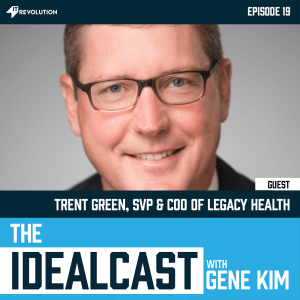
Thursday Jun 10, 2021
Thursday Jun 10, 2021
In March of 2021, Gene Kim visited the mass vaccination site at the Oregon Convention Center in Portland, which has been described by the press as a logistical masterpiece where over 465,000 Oregonians have been vaccinated as of May 2021.
After a three-hour tour of the site, Gene Kim sat down with Trent Green, Senior Vice President and Chief Operating Officer (COO) at Legacy Health and one of the organizers of the mass vaccination operation. Kim and Green discuss firsthand what it looks like to vaccinate 8,000 people a day and the strategic level of planning it took to produce and operate the mass vaccination clinic.
Green reveals what those first few days of operation were like and how the site was able to increase distribution from 2,000 vaccines per day to 8,000 per day. Lastly, he discusses the lessons he learned during the rollout process and how those lessons can inform how to improve the overall health care system.
Also joining the conversation is Dr. Steve Spear, who has helped the Pittsburgh Regional Healthcare Initiative create its “Perfecting Patient Care System” and has worked on a few pilot programs with Beth Israel Deaconess Medical Center in Boston.
ABOUT THE GUESTS
Trent Green, COO of Legacy Health, focusing on innovation in Legacy Health’s hospital operations and service lines, and responsible for Legacy Laboratory Services, Legacy Imaging Services and Unity Center. Green oversees the OHSU Knight-Legacy Health Cancer Collaborative, the LifeFlight partnership, as well as other ventures that directly impact hospital operations. Prior to his most recent role, Green served as Legacy Health’s senior vice president, chief strategy officer, and president of Legacy Medical Group. He brings more than 20 years of experience in leading health care organizations, with specific strengths and accomplishments in clinic and hospital operations, strategic planning, business development, marketing, mergers and acquisitions, and finance.
Green’s notable achievements include advancing a re-imagined Master Facility Plan for the Legacy Emanuel and Randall Children’s Hospital campus; navigating a complex regulatory situation at Unity Center by providing decisive leadership and a unified approach to problem-solving, resulting in the successful restoration of status, cultural alignment, best in system performance on medication administration practices, and accelerated incident review and mitigation implementation practices. He also led and developed several of Legacy’s most transformational initiatives, including the PacificSource joint venture, Silverton Health affiliation, Legacy-GoHealth urgent care joint venture, and the OHSU Knight–Legacy Health Cancer Collaborative, among others.
Dr. Steve Spear (DBA MS MS) is principal for HVE LLC, the award-winning author of The High-Velocity Edge, and patent holder for the See to Solve Real Time Alert System. A Senior Lecturer at MIT’s Sloan School and a Senior Fellow at the Institute, Dr. Spear’s work focuses on accelerating learning dynamics within organizations so that they know better and faster what to do and how to do it. This has been informed and tested in practice in multiple industries including heavy industry, high tech design, biopharm R&D, healthcare delivery and other social services, US Army rapid equipping, and US Navy readiness.
YOU’LL LEARN ABOUT
- Green’s role as the Chief Operating Officer, how it compares to the Chief Medical Officer, and what are the other key leadership roles in a healthcare organization
- The strategic level of planning, human creativity, and problem-solving it took to produce and operate the mass vaccination clinic as efficient as possible
- Green’s role and the various leadership roles at the vaccination clinic
- What the first days of operations at the vaccination site were like
- The major milestones Green saw as distribution increased from 2,000 vaccines per day to 8,000 vaccines per day
- Fast versus slow integrated problem-solving styles and theory building versus theory testing
- The lessons Green has learned during the COVID vaccination rollout process and how these lessons could inform how to improve the overall health care system
RESOURCES
- Trent Green’s bio at Legacy Health
- Legacy Health
- Videos from DevOps Enterprise Summit Virtual - Europe
- NPR: Half Of All U.S. Adults Are Now Fully Vaccinated Against COVID-19
- Willamette Week: Oregon’s Largest Vaccination Site is a Logistical Masterpiece. We Take You Inside.
- Tweet describing the vaccination site with “apocalypse vibe”
- The Unicorn Project: A Novel about Developers, Digital Disruption, and Thriving in the Age of Data by Gene Kim
- FEMA Region 10’s video featuring Starbucks and Trent Green
- The Indicator from Planet Money: Why Hospitals Are Laying People Off
- The Indicator from Planet Money: Healthcare: The Pandemic's Financial Fallout
- Operation Warp Speed
- Eroom's law
- Fast and Slow Integrated Problem Solving Structures with Gene Kim and Dr. Steve Spear
- Team of Teams: New Rules of Engagement for a Complex World by General Stanley A. McChrystal with Chris Fussell, David Silverman, Tantum Collins
- Mastering Outages with Incident Command for DevOps: Learning from the Fire Department
- Decoding the DNA of the Toyota Production System by Dr. Steven Spear and H. Kent Bowen
- Thinking, Fast and Slow by Daniel Kahneman
- The DevOps Enterprise Journal: White Papers from the 2020 DevOps Enterprise Summits
- The High-Velocity Edge: How Market Leaders Leverage Operational Excellence to Beat the Competition by Steven J. Spear
- The DevOps Enterprise Journal: White Papers from the 2020 DevOps Enterprise Summits
- The PDSA Cycle (Plan-Do-Study-Act)
- Leadership Lessons Learned From Improving Flow In Hospital Settings using Theory of Constraints by Dr. Chris Strear
- Smash the Bottleneck: Fixing Patient Flow for Better Care (and a Better Bottom Line) by Dr. Chris Strear and Danilo Sirias
- Bleacher Report: A Detailed List of an NFL Coach's Responsibility
- Walter A Shewhart, 1924, and the Hawthorne factory by M Best and D Neuhauser
TIMESTAMPS
[00:20] Intro
[04:39] Meet Trent Green
[06:19] Key leadership positions in a healthcare organizations
[07:52] Meet Steve Spear and his work in the healthcare industry
[11:13] The early days of the operations
[14:02] The major milestones from increasing distribution
[20:42] Steve’s thoughts on an organization’s ability to adapt
[24:42] The DevOps Enterprise Summit videos and journal
[25:35] Continuation of Steve’s thoughts
[26:56] The path of good ideas and barriers
[32:04] Trent’s role at the vaccination site
[36:15] The strategic level of planning
[39:19] Two interviews with Dr. Patrick Cawley and Eroom's law
[47:31] Gene’s firsthand observations at the vaccination site
[54:40] Fast vs. slow integrated problem-solving styles
[1:01:58] Lesson learned in the vaccination process
[1:09:50] Uncovering constraints
[1:22:25] Cost of change goes down, frequency of change goes up
[1:25:46] Becoming an effective coach
[1:30:19] Gene adds additional context
[1:36:57] Contacting Trent Green
[1:38:05] Outro
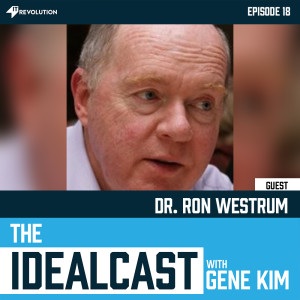
Thursday May 20, 2021
Thursday May 20, 2021
In the second part of this two-part episode of The Idealcast, Gene Kim continues his conversation with Dr. Ron Westrum, Emeritus Professor of Sociology at Eastern Michigan University and creator of the Westrum organization typology model.
In part two of their conversation, Kim and Westrum talk about generative cultures and why Westrum thinks they are more important now than it they were a hundred years ago. Westrum also shares his observations on the increasing number of functional specialities in organizations. He discusses the challenges that arise from having matrixed organizations and the tools to overcome these challenges.
Finally, Westrum previews the new book he’s working on about information flow within organizations.
ABOUT THE GUEST
Ron Westrum is Emeritus Professor of sociology at Eastern Michigan University. He holds a B.A. (honors) from Harvard University and a Ph.D in Sociology from the University of Chicago.
Dr. Westrum is a specialist in the sociology of science and technology, and on complex organizations. He has written three books, Complex Organizations: Growth, Development and Change; Technologies and Society: The Shaping of People and Things, and Sidewinder: Creative Missile Design at China Lake. He has also written about fifty articles and book chapters. His work on organizational culture has been valuable for the aviation industry and to medical safety, as well as to other areas of endeavor. He has been a consultant to NASA, the National Research Council, and the Resilience Core Group. He is currently at work on a book on information flow cultures.
YOU’LL LEARN ABOUT
- Why Westrum thinks creating generative cultures is more important now than it was 100 years ago
- His observations on the increasing number of functional specialities and how long it’s been going on
- The challenges that arise from having matrix organizations and the tools to overcome these challenges
- The book he’s working on about information flow within organizations, what areas he’s pursuing and what has surprised him as he delves into specific examples
RESOURCES
- The Sociology and Typologies of Organizations, and Technical Maestros with Dr. Ron Westrum
- Sidewinder: Creative Missile Design at China Lake by Ron Westrum
- Fukushima Daiichi nuclear disaster
- The Citigroup Center (formerly Citicorp Center)
- Latent human error
- Freedom's Forge: How American Business Produced Victory in World War II by Arthur Herman
- Admiral Thomas Moore
- Horatio Nelson, 1st Viscount Nelson
- Lying to Ourselves: Dishonesty in the Army Profession by Dr. Leonard Wong and Dr. Stephen J. Gerras
- The Generals: American Military Command from World War II to Today by Thomas E. Ricks
- The Inmates Are Running the Asylum: Why High Tech Products Drive Us Crazy and How to Restore the Sanity by Alan Cooper
- Team of Teams: New Rules of Engagement for a Complex World by General Stanley A. McChrystal with Chris Fussell, David Silverman, Tantum Collins
- Hubble Space Telescope
- NOVA - Aircraft Carrier
- 21st Century Jet - Building the Boeing 777
- Boeing to Buy McDonnell Douglas
- Extended-range Twin-engine Operations Performance Standards (ETOPS)
- Alan Mulally
- Technology in Retrospect and Critical Events in Science (TRACES)
- General George C. Marshall
- The Marshall Plan on NPR’s Planet Money
- 2015 State Of DevOps Report
- Westrum organizational culture
- The study of information flow: A personal journey by Ron Westrum
- Stand and Deliver
- Mayo Clinic
- How a Friendly Fire Tragedy in Sicily Transformed Airborne Warfare
- The New Heat On Ford
- Email Ron Westrum
TIMESTAMPS
[00:00] Intro
[02:39] Why generative cultures are more important now
[14:50] Exposing latent pathogens
[19:39] Gene’s thoughts and a few corrections
[28:59] The increase in silos
[34:53] How Westrum would organize the organization
[40:42] Why matrix organizations are fundamentally unstable and how to cope
[44:57] LaunchDarkly and DevOps Enterprise Summit Virtual
[46:47] Matrix organizations and how to help increase likelihood of success
[57:26] Building the Boeing 777
[1:06:24] Where generative characteristics came from
[1:11:10] Bridging the world of R&D to the world of operations
[1:14:58] Team of Teams example
[1:20:09] General George C. Marshall
[1:24:35] Other mechanisms Westrum has seen in high performing teams
[1:32:30] Westrum’s new book
[1:38:53] What DevOps has helped Westrum
[1:39:47] Contacting Admiral Richardson
[1:41:36] Outro
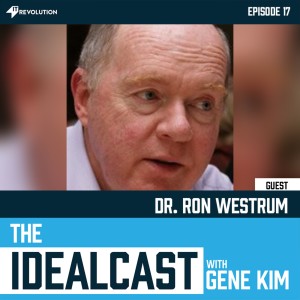
Thursday May 06, 2021
Thursday May 06, 2021
In the first part of this two-part episode of The Idealcast, Gene Kim speaks with Dr. Ron Westrum, Emeritus Professor of sociology at Eastern Michigan University. His work on organizational culture and his contribution of the Westrum organizational typology model have been instrumental in understanding what makes a high-performing organization across industries. For decades, he has studied complex organizations from medicine to aviation to the nuclear industry.
In part one of their conversation, Kim and Westrum talk about the stark contrast between NASA’s highly experimental culture of the Apollo space program versus the highly compliance-driven culture of the US Space Shuttle program, and Westrum’s opinions on how to bring that experimental culture back. They also discuss the origins of the Westrum organizational typology model and some of the insights that led to it. Finally, Westrum shares what organizations should do when things go wrong in complex systems.
ABOUT THE GUEST
Dr. Ron Westrum is Emeritus Professor of sociology at Eastern Michigan University. He holds a B.A. (honors) from Harvard University and a Ph.D. in Sociology from the University of Chicago.
Dr. Westrum is a specialist in the sociology of science and technology and complex organizations. He has written three books, Complex Organizations: Growth, Development and Change; Technologies and Society: The Shaping of People and Things, and Sidewinder: Creative Missile Design at China Lake. He has also written about fifty articles and book chapters. His work on organizational culture has been valuable for the aviation industry and to medical safety, as well as to other areas of endeavor. He has been a consultant to NASA, the National Research Council, and the Resilience Core Group. He is currently at work on a book on information flow cultures.
YOU’LL LEARN ABOUT
- Why much of the body of knowledge around safety culture came from sociology as opposed to psychology.
- How Westrum views the stark contrast in NASA between the highly experimental culture of the Apollo space program versus what has been characterized as a highly compliance-driven culture of the US Space Shuttle program.
- Insightful and useful opinions on what would be required to bring that experimental culture back in NASA.
- The origins of the Westrum organization typology model and some of the insights that led to it.
- Why Westrum views the notion of a technical maestro important to get the desired outcomes.
- What Westrum thinks should ideally happen when things go wrong in complex systems.
RESOURCES
- State of DevOps Reports
- Westrum organizational culture
- The study of information flow: A personal journey by Ron Westrum
- Sidewinder: Creative Missile Design at China Lake by Ron Westrum
- Complex Organizations: Growth, Development and Change by Ron Westrum
- Normal Accidents: Living with High-Risk Technologies by Charles Perrow
- Crew resource management or cockpit resource management (CRM)
- The Human Factor in Aircraft Accidents by David Beaty
- Naked Pilot: The Human Factor in Aircraft Accidents by David Beaty
- United Airlines Flight 232
- Cockpit Voice Recorder Database
- Captain Al Haynes' 1991 lecture at NASA Ames Research Center
- It's Your Ship: Management Techniques from the Best Damn Ship in the Navy by Michael Abrashoff
- Apollo 13
- Space Shuttle Challenger disaster
- Space Shuttle Columbia disaster
- CBS News article: "Readdy says 'no rationale' for spy satellite inspection"
- Apollo 13 (1995) - Square Peg in a Round Hole Scene
- Health inequalities among British civil servants: the Whitehall II study by Jane Ferrie, Martin J Shipley, George Davey Smith, Stephen A Stansfeld and Michael G Marmot
- Facing Ambiguous Threats by Michael Roberto, Richard M.J. Bohmer, and Amy C. Edmondson
- DevOps Enterprise Summit Virtual
- Nasa Cut or Delayed Safety Spending by Stuart Diamond
- Mars Curiosity Rover Landing Space 2015
- How Apple Is Organized for Innovation by Joel M. Podolny and Morten T. Hansen
- Arthur Squires
- The Tender Ship: Governmental Management of Technological Change by Arthur Squires
- Jacob Rabinow
- Federal Research and Development Expenditures and the National Economy: Hearings Before the Subcommittee on Domestic and International Scientific Planning and Analysis of the Committee on Science and Technology, U.S. House of Representatives, Ninety-fourth Congress, Second Session
- Turn the Ship Around!: A True Story of Turning Followers into Leaders by L. David Marquet
- Excellence in the Surface Navy by Gregg G. Gullickson
- Excellence in the Surface Navy by Gregg G. Gullickson, Richard D. Chenette and Reuben T. Harris
- How NASA Builds Teams: Mission Critical Soft Skills for Scientists, Engineers, and Project Teams by Charles J. Pellerin
- The Generals: American Military Command from World War II to Today by Thomas E. Ricks
- George C. Marshall: Four (4) Volumes - Education of a General, 1880-1939; Ordeal and Hope, 1939-1943; Organizer of Victory, 1943-1945; Statesman, 1945-1959 by Forrest C. Pogue
- Team of Teams: New Rules of Engagement for a Complex World by General Stanley A. McChrystal with Chris Fussell, David Silverman, Tantum Collins
- Forge of Democracy by Neil MacNeil
- Freedom's Forge: How American Business Produced Victory in World War II by Arthur Herman
- Email Ron Westrum
TIMESTAMPS
[00:00] Intro
[04:01] Meet Ron Westrum
[07:19] Why prominent figures in the safety field come from sociology
[08:38] Observations about the work on airline safety
[11:17] How Ron’s work is relevant and why culture is important
[16:56] Apollo 13 and Space Shuttle Columbia disaster
[23:15] Westrum organization typology model
[24:38] United Airlines Flight 232
[34:45] Understanding the dynamics of generative organizations
[41:57] Three western typologies beyond the table
[50:16] The Whitehall II study
[53:05] What the word generative means to Ron
[55:31] The two NASAs and how he would drive out fear
[58:44] LaunchDarkly and DevOps Enterprise Summit Virtual
[1:00:37] What Ron imagines would cause a different outcome as NASA
[1:08:40] It matters who’s at the top
[1:12:18] The technological maestro concept
[1:16:38] How the technological maestro concept applies
[1:26:20] How these characteristics can be learned
[1:28:51] Building a community of good judgment
[1:33:39] The role of CNO
[1:35:27] How organizations learn and adapt generative capabilities
[1:42:01] What should ideally happen when something goes wrong
[1:45:41] Information flow, organization’s nervous system, and management
[1:48:01] Contacting Admiral Richardson
[1:49:06] Outro
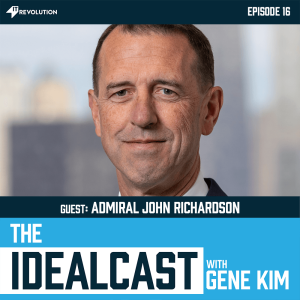
Thursday Apr 22, 2021
Thursday Apr 22, 2021
In the second part of this two-part episode of The Idealcast Gene Kim and Admiral John Richardson, former Chief of Naval Operations, continue their discussion on the importance of leadership in large, complex organizations, especially enabling leadership training early in one’s career, and exploring why he views it as so important. Admiral Richardson also shares why radical delegation is needed more than ever, and provides tools and techniques for enabling it.
Kim and Admiral Richardson discuss the important characteristics needed to integrate problems solving into an organization. And finally, they talk about the nature of the US Naval Reactors that are responsible for the safe and reliable operations of the US Naval Propulsion Program, why that warrants the command of a 4-star admiral, and what should ideally happen when accidents occur in complex systems.
Also joining the conversation is Dr. Steve Spear, who has written extensively about the US Naval Nuclear Propulsion Program program in his book The High-Velocity Edge.
ABOUT THE GUESTS
Admiral John Richardson served as the Chief of Naval Operations for four years, which is the professional head of the US Navy. While in the Navy, Richardson served in the submarine force and commanded the attack submarine USS Honolulu in Pearl Harbor, Hawaii, for which he was awarded the Vice Admiral James Bond Stockdale Inspirational Leadership Award. He also served as the Director of Naval Reactors, responsible for the design, safety, certification, operating standards, material control, maintenance, disposal, and regulatory oversight of over 100 nuclear power plants operating on nuclear-powered warships deployed around the world.
Since his retirement in August 2019, he has joined the boards of several major corporations and other organizations, including Boeing, the world's largest aerospace company, and Exelon, a Fortune 100 company that operates the largest fleet of nuclear plants in America and delivers power to over 10 million customers.
Dr. Steve Spear (DBA MS MS) is principal for HVE LLC, the award-winning author of The High-Velocity Edge, and patent holder for the See to Solve Real Time Alert System. A Senior Lecturer at MIT’s Sloan School and a Senior Fellow at the Institute, Dr. Spear’s work focuses on accelerating learning dynamics within organizations so that they know better and faster what to do and how to do it. This has been informed and tested in practice in multiple industries including heavy industry, high tech design, biopharm R&D, healthcare delivery and other social services, US Army rapid equipping, and US Navy readiness.
YOU’LL LEARN ABOUT
- Admiral Richardson’s views on the importance of training leadership in the earliest stages of a sailor’s career
- Why leadership is so important
- Various tools and techniques for enabling radical delegation
- Important characteristics of the different ways that integrated problem solving incurs in organizations
- The nature of the function organization that is the U.S. Naval reactors, comprehensively responsible for safe and reliably operations of the US Naval Propulsion Program and why it warrants being commanded by a four-star admiral
- What should leaders in complex organizations do when accidents occur
RESOURCES
- Leadership Development and Balancing Creativity and Control with Admiral John Richardson (Part I)
- The Visual Display of Quantitative Information by Edward Tufte
- Navy Leader Development Framework
- A Design for Maintaining Maritime Superiority v. 1
- A Design for Maintaining Maritime Superiority v. 2
- Amazon Staff Meetings: “No Powerpoint”
- Amazon’s Jeff Bezos: The Ultimate Disrupter by Adam Lashinsky
- How are the six-page narratives structured in Jeff Bezos' S-Team meetings?
- Flipped meetings: Learning from Amazon’s meeting policy by Stowe Boyd
- The Visual Display of Quantitative Information by Edward Tufte
- Beautiful Evidence by Edward Tufte
- The High-Velocity Edge: How Market Leaders Leverage Operational Excellence to Beat the Competition by Steven J. Spear
- Team of Teams: New Rules of Engagement for a Complex World by General Stanley A. McChrystal, Chris Fussell, David Silverman and Tantum Collins
- The Unicorn Project: A Novel about Developers, Digital Disruption, and Thriving in the Age of Data by Gene Kim
- Michael Nygard’s episodes on The Idealcast Part 1, summit presentations, and Part 2
- Thinking, Fast and Slow by Daniel Kahneman
- Thinking, Fast and Slow’s Wikipedia page
- The Idealcast episodes featuring David Silverman and Jessica Reif Part 1 and Part 2
TIMESTAMPS
[00:00] Intro
[01:24] Toughing up the training
[09:37] Feedback from the fleet
[11:00] Discussions with the instructors
[14:03] A Design for Maintaining Maritime Superiority
[18:07] Designing for the next place
[28:18] Reducing the cost of change
[35:22] Configurations for failure or success
[39:55] Tools for integration
[47:39] How structure affects the dynamics of how organizations work
[51:59] Gene reflects on integrated problem solving
[57:28] Two domains of activities to use the slow communication paths
[1:00:42] If these mental models resonate with Admiral Richardson
[1:02:31] What point does the center get involved
[1:07:47] Why the delegation for the nuclear reactor core is important
[1:14:00] What happens when complex systems go wrong
[1:20:37] Contacting Admiral Richardson

